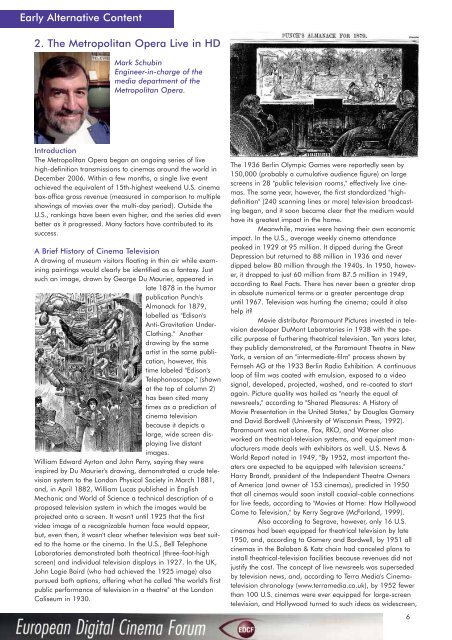The EDCF Guide to ALTERNATIVE CONTENT in Digital Cinema
The EDCF Guide to ALTERNATIVE CONTENT in Digital Cinema
The EDCF Guide to ALTERNATIVE CONTENT in Digital Cinema
Create successful ePaper yourself
Turn your PDF publications into a flip-book with our unique Google optimized e-Paper software.
Early Alternative Content<br />
2. <strong>The</strong> Metropolitan Opera Live <strong>in</strong> HD<br />
Mark Schub<strong>in</strong><br />
Eng<strong>in</strong>eer-<strong>in</strong>-charge of the<br />
media department of the<br />
Metropolitan Opera.<br />
Introduction<br />
<strong>The</strong> Metropolitan Opera began an ongo<strong>in</strong>g series of live<br />
high-def<strong>in</strong>ition transmissions <strong>to</strong> c<strong>in</strong>emas around the world <strong>in</strong><br />
December 2006. With<strong>in</strong> a few months, a s<strong>in</strong>gle live event<br />
achieved the equivalent of 15th-highest weekend U.S. c<strong>in</strong>ema<br />
box-office gross revenue (measured <strong>in</strong> comparison <strong>to</strong> multiple<br />
show<strong>in</strong>gs of movies over the multi-day period). Outside the<br />
U.S., rank<strong>in</strong>gs have been even higher, and the series did even<br />
better as it progressed. Many fac<strong>to</strong>rs have contributed <strong>to</strong> its<br />
success.<br />
A Brief His<strong>to</strong>ry of C<strong>in</strong>ema Television<br />
A draw<strong>in</strong>g of museum visi<strong>to</strong>rs float<strong>in</strong>g <strong>in</strong> th<strong>in</strong> air while exam<strong>in</strong><strong>in</strong>g<br />
pa<strong>in</strong>t<strong>in</strong>gs would clearly be identified as a fantasy. Just<br />
such an image, drawn by George Du Maurier, appeared <strong>in</strong><br />
late 1878 <strong>in</strong> the humor<br />
publication Punch's<br />
Almanack for 1879,<br />
labelled as "Edison's<br />
Anti-Gravitation Under-<br />
Cloth<strong>in</strong>g." Another<br />
draw<strong>in</strong>g by the same<br />
artist <strong>in</strong> the same publication,<br />
however, this<br />
time labeled "Edison's<br />
Telephonoscope," (shown<br />
at the <strong>to</strong>p of column 2)<br />
has been cited many<br />
times as a prediction of<br />
c<strong>in</strong>ema television<br />
because it depicts a<br />
large, wide screen display<strong>in</strong>g<br />
live distant<br />
images.<br />
William Edward Ayr<strong>to</strong>n and John Perry, say<strong>in</strong>g they were<br />
<strong>in</strong>spired by Du Maurier's draw<strong>in</strong>g, demonstrated a crude television<br />
system <strong>to</strong> the London Physical Society <strong>in</strong> March 1881,<br />
and, <strong>in</strong> April 1882, William Lucas published <strong>in</strong> English<br />
Mechanic and World of Science a technical description of a<br />
proposed television system <strong>in</strong> which the images would be<br />
projected on<strong>to</strong> a screen. It wasn't until 1925 that the first<br />
video image of a recognizable human face would appear,<br />
but, even then, it wasn't clear whether television was best suited<br />
<strong>to</strong> the home or the c<strong>in</strong>ema. In the U.S., Bell Telephone<br />
Labora<strong>to</strong>ries demonstrated both theatrical (three-foot-high<br />
screen) and <strong>in</strong>dividual television displays <strong>in</strong> 1927. In the UK,<br />
John Logie Baird (who had achieved the 1925 image) also<br />
pursued both options, offer<strong>in</strong>g what he called "the world's first<br />
public performance of television <strong>in</strong> a theatre" at the London<br />
Coliseum <strong>in</strong> 1930.<br />
<strong>The</strong> 1936 Berl<strong>in</strong> Olympic Games were reportedly seen by<br />
150,000 (probably a cumulative audience figure) on large<br />
screens <strong>in</strong> 28 "public television rooms," effectively live c<strong>in</strong>emas.<br />
<strong>The</strong> same year, however, the first standardized "highdef<strong>in</strong>ition"<br />
(240 scann<strong>in</strong>g l<strong>in</strong>es or more) television broadcast<strong>in</strong>g<br />
began, and it soon became clear that the medium would<br />
have its greatest impact <strong>in</strong> the home.<br />
Meanwhile, movies were hav<strong>in</strong>g their own economic<br />
impact. In the U.S., average weekly c<strong>in</strong>ema attendance<br />
peaked <strong>in</strong> 1929 at 95 million. It dipped dur<strong>in</strong>g the Great<br />
Depression but returned <strong>to</strong> 88 million <strong>in</strong> 1936 and never<br />
dipped below 80 million through the 1940s. In 1950, however,<br />
it dropped <strong>to</strong> just 60 million from 87.5 million <strong>in</strong> 1949,<br />
accord<strong>in</strong>g <strong>to</strong> Reel Facts. <strong>The</strong>re has never been a greater drop<br />
<strong>in</strong> absolute numerical terms or a greater percentage drop<br />
until 1967. Television was hurt<strong>in</strong>g the c<strong>in</strong>ema; could it also<br />
help it?<br />
Movie distribu<strong>to</strong>r Paramount Pictures <strong>in</strong>vested <strong>in</strong> television<br />
developer DuMont Labora<strong>to</strong>ries <strong>in</strong> 1938 with the specific<br />
purpose of further<strong>in</strong>g theatrical television. Ten years later,<br />
they publicly demonstrated, at the Paramount <strong>The</strong>atre <strong>in</strong> New<br />
York, a version of an "<strong>in</strong>termediate-film" process shown by<br />
Fernseh AG at the 1933 Berl<strong>in</strong> Radio Exhibition. A cont<strong>in</strong>uous<br />
loop of film was coated with emulsion, exposed <strong>to</strong> a video<br />
signal, developed, projected, washed, and re-coated <strong>to</strong> start<br />
aga<strong>in</strong>. Picture quality was hailed as "nearly the equal of<br />
newsreels," accord<strong>in</strong>g <strong>to</strong> "Shared Pleasures: A His<strong>to</strong>ry of<br />
Movie Presentation <strong>in</strong> the United States," by Douglas Gomery<br />
and David Bordwell (University of Wiscons<strong>in</strong> Press, 1992).<br />
Paramount was not alone. Fox, RKO, and Warner also<br />
worked on theatrical-television systems, and equipment manufacturers<br />
made deals with exhibi<strong>to</strong>rs as well. U.S. News &<br />
World Report noted <strong>in</strong> 1949, "By 1952, most important theaters<br />
are expected <strong>to</strong> be equipped with television screens."<br />
Harry Brandt, president of the Independent <strong>The</strong>atre Owners<br />
of America (and owner of 153 c<strong>in</strong>emas), predicted <strong>in</strong> 1950<br />
that all c<strong>in</strong>emas would soon <strong>in</strong>stall coaxial-cable connections<br />
for live feeds, accord<strong>in</strong>g <strong>to</strong> "Movies at Home: How Hollywood<br />
Came <strong>to</strong> Television," by Kerry Segrave (McFarland, 1999).<br />
Also accord<strong>in</strong>g <strong>to</strong> Segrave, however, only 16 U.S.<br />
c<strong>in</strong>emas had been equipped for theatrical television by late<br />
1950, and, accord<strong>in</strong>g <strong>to</strong> Gomery and Bordwell, by 1951 all<br />
c<strong>in</strong>emas <strong>in</strong> the Balaban & Katz cha<strong>in</strong> had canceled plans <strong>to</strong><br />
<strong>in</strong>stall theatrical-television facilities because revenues did not<br />
justify the cost. <strong>The</strong> concept of live newsreels was superseded<br />
by television news, and, accord<strong>in</strong>g <strong>to</strong> Terra Media's C<strong>in</strong>ematelevision<br />
chronology (www.terramedia.co.uk), by 1952 fewer<br />
than 100 U.S. c<strong>in</strong>emas were ever equipped for large-screen<br />
television, and Hollywood turned <strong>to</strong> such ideas as widescreen,<br />
6



